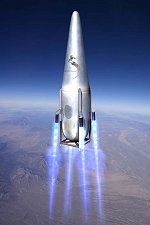How to determine whether a company is a "NewSpace" company or not is still an open question.
July 27, 2008: The Original Definition on this Wiki
"NewSpace" companies are characterized by five traits:
a. Personal or private financial investment.
b. Achievement of technologically siginificant feats.
c. Substantial reliance on non-government customers.
d. An avoidance of government "cost-plus" contracting methods and controls.
e. Highly sensitive to launch costs.
I have recently begun thinking of "newspace" as "new space markets" as a way to differentiate it from "traditional space markets", a term that include the telecommunications industry.
July 28, 2008: An Alternative Definition (from Jeff Krukin's Website)
The term “NewSpace” evolved from “alt.space,” a term used in the 1980’s and 1990’s to identify the alternative space community that was attempting to conduct space activity in a considerably different manner from NASA and its contractors. This is the emerging commercial space industry, the antithesis of the decades-old civil space program we know as NASA and its large contractors like Boeing, Lockheed Martin, and so forth. Today, this primarily means entrepreneurs and small- or medium-size firms that have one or more of these characteristics:
a. Space-related products and services are sold from a fixed-price catalog
b. Customers include individual consumers and other non-government entities, as well as civil and government entities
c. The company is funded primarily by the owner(s), angel investors, and/or venture capital
d. A significant portion of the company’s revenue is earned from non-government entities
August 3, 2010: Our Latest Attempt...
Attempts have been made to characterize these companies, but questions remain whether the definition should actually be applied to individual companies at all. The counter-proposal is that the term "NewSpace" is better applied to an industry or a project instead.
So far, the best "definition" I've seen for identifying a NewSpace company comes from Clark Lindsey's HobbySpace web pages. His NewSpace page includes a Definition section, but I've copied it here for convenience's sake:
Defining NewSpace |
|
One of the vertical takeoff and landing suborbital vehicles currently in development by Armadillo Aerospace. |
|
NewSpace does not have a hard, fast definition. It tends to be one of those "we know it when we see it" sort of labels. However, if a company, or perhaps a "skunkworks" type of project within a mainstream company, possesses at least three or four of the following characteristics, it would certainly fall under the NewSpace category:
|
2013 October 6: Greg Autry's Definition of "New Space"
What follows are quotes and excerpts from Greg Autry's Ph.D. Thesis entitled "Exploring New Space: Governmental Roles in the Emergence of New Communities of High-Technology Organizations", accepted in July 2013.
"New Space" Context
NOTE: Greg uses the terms "field", "community", "population" and "organization" in the context of social ecology. Specifically:
1. "Field" = "Related Communities" such as Aerospace.
2. "Community" = "Related Industries" such as New Space.
3. "Population" would be roughly equivalent to "Industry", such as Space Tourism, but could include gov't and non-profits sectors.
4. "Organization" would be roughly equivalent to individual "Firms", such as Virgin Galactic, but could also include gov't offices and NGOs.
"by 2013, the 12 distinct populations consisting of 45 private, fee-for-service firms, providing space-launch services, products and support outside of the traditional military-industrial-complex demonstrate that the new space industry has emerged and differentiated into a multi-population community."
The 12 distinct populations include:
- Satellite Manufacturing
- Fuel Depot-In Space Supply
- Orbital Human Transport
- Orbital Payload
- Point-to-Point Transport
- Resource Extraction
- Commercial Research
- Space Station
- Space Tourism
- Spaceport Operations
- Suborbital Payload
- Support Services
"New Space" Definition
"The general definition of New Space organizations is organizations within the collection of industries based on the use of space rocketry in a competitive, commercial context."
Characteristic 1: Use of Space Rocketry
Characteristic 2: Competitive, Commercial Context
"the New Space population do not include any U.S. government sourced cost-plus products and services produced by what is commonly referred to as the military-industrial-complex."
"The de novo New Space firms are differentiated by their preferences for fee for service contracting."
"It is the adaptation to this open, competitive and commercial regulatory environment, rather than the technology itself, that differentiates the New Space community from the traditional, cost-plus, military-industrial aerospace organizations and populations."
"The identity differentiation between a New Space firm such as SpaceX and a military-industrial-complex (MIC) firm, such as Lockheed Martin is primarily in the accounting (cost-plus versus fee for service)."
"It is important to note that two other quasi-New Space firms exist: United Launch Alliance (ULA) and Orbital Sciences Corp (Orbital.)... I do not include either firm in this analysis, as they are, at the time, members of the military-industrial-complex, rather than representative of the New Space phenomena. However, both firms have claimed an entrepreneurial ethos and are transitioning to a fully commercial model "
Other Characteristics
"The market place for new space firms is global, in that space tourists and potential commercial payloads may come from any country."
"It is important to note that New Space varies from many other communities in that it has a sense of greater purpose to establish mankind’s future in space."
"New Space" Firms
"Currently nearly a hundred New Space firms have announced that they are competing in the industries. Many of these are shoestring operations, of questionable credibility; lacking offices, revenue, capital and employees."
"Several New Space firms were found to be little more than a web site and a collection of press releases."
